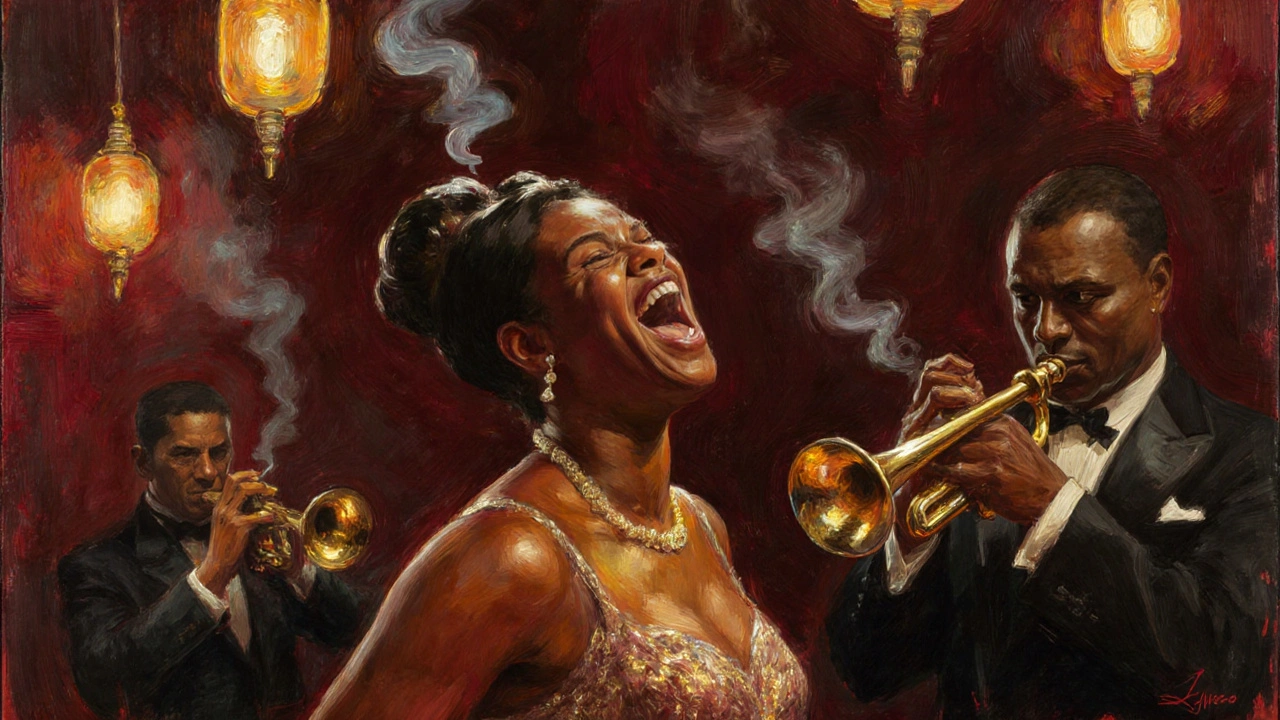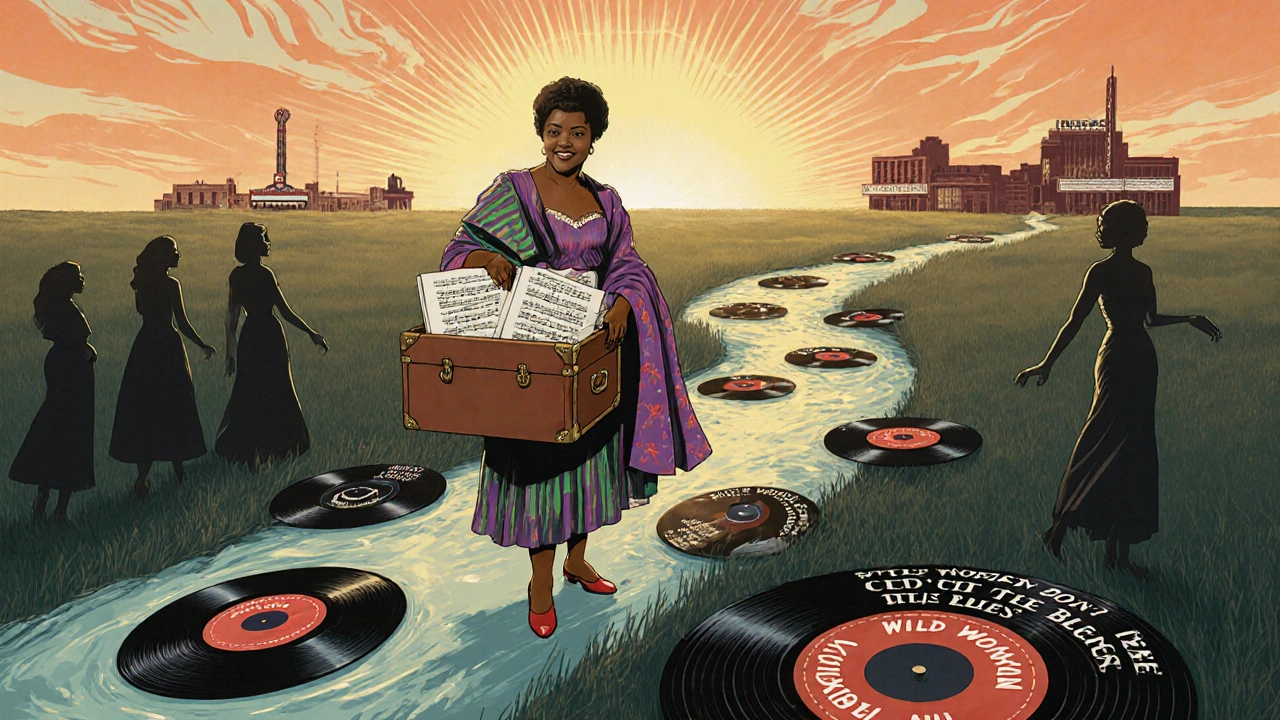Blues Women Quiz
Test Your Knowledge
How much do you know about the women who shaped blues music? Answer 5 multiple-choice questions to see your score.
Results
Why these women matter:
These women didn't just sing the blues—they defined it. They gave voice to the voiceless, turned personal pain into public art, and built careers when the system was designed to keep them out.
Blues music didn’t just happen. It was built by people-mostly Black women-who sang through pain, power, and pride when the world refused to listen. These women didn’t wait for permission. They walked into recording studios, took over juke joints, and turned personal suffering into universal anthems. Their voices didn’t just carry melodies; they carried history.
Ma Rainey: The Mother of the Blues
Before Bessie Smith became a star, there was Ma Rainey. Born in 1886 in Georgia, she started performing in traveling tent shows as a teenager. By the 1910s, she was known across the South as the “Mother of the Blues.” Her voice was raw, powerful, and unmistakable-full of grit and soul. She didn’t sing pretty. She sang real.
In 1923, she became one of the first blues artists to record commercially. Her song “Bo-Weevil Blues” sold over 200,000 copies in its first year. That wasn’t just success-it was a revolution. At a time when Black women had little control over their lives, Ma Rainey controlled her career. She booked her own tours, hired her own band, and wrote lyrics that spoke openly about poverty, infidelity, and queer identity. She didn’t hide who she was. She made sure the world heard it.
Bessie Smith: The Empress of the Blues
If Ma Rainey laid the foundation, Bessie Smith built the palace. Born in Chattanooga in 1894, she was raised in poverty and began singing on street corners to survive. By 1923, she signed with Columbia Records and became the highest-paid Black entertainer in the country. Her 1925 recording of “Downhearted Blues” sold over 780,000 copies in six months.
Her voice wasn’t just loud-it was emotional. She could make you cry with a single note. Critics called her the “Empress of the Blues,” and she earned every inch of that title. She sang about being cheated on, losing a man to another woman, and surviving violence. Her songs weren’t abstract poetry. They were newspaper headlines set to music.
She didn’t just perform. She changed how music was made. She worked with top jazz musicians like Louis Armstrong and Fletcher Henderson, blending blues with early jazz in ways that pushed the genre forward. Her recordings became the blueprint for generations of singers-from Billie Holiday to Janis Joplin.
Ida Cox: The Queen of the Blues Stage
While Ma Rainey and Bessie Smith dominated the recording studios, Ida Cox ruled the live circuit. Born in 1896 in Georgia, she was a touring powerhouse. She performed in theaters, churches, and backwoods juke joints across the Midwest and South. Unlike many of her peers, she wrote most of her own songs-sharp, witty, and unapologetic.
Her 1925 hit “Wild Women Don’t Get the Blues” wasn’t just a song. It was a manifesto. “I ain’t got no man, but I got my own way,” she sang. That line became a battle cry for women who refused to be defined by men. She sang about independence, self-respect, and sexual freedom at a time when women were expected to stay quiet and stay home.
Cox didn’t need a record deal to be influential. She toured for over 40 years, often carrying her own trunk of costumes and sheet music. She taught younger singers how to command a stage. Many of them, including Alberta Hunter and Clara Smith, credited her as their mentor.

Victoria Spivey: The Businesswoman of the Blues
Victoria Spivey didn’t just sing the blues-she owned them. Born in 1906 in Texas, she recorded her first song at age 19 and quickly became known for her clever lyrics and smooth delivery. But what set her apart wasn’t just her voice-it was her business sense.
In 1962, she co-founded Spivey Records, one of the first blues labels owned by a Black woman. She re-recorded her old hits and signed new artists, including Big Joe Williams and Lonnie Johnson. She didn’t wait for someone else to revive the blues. She did it herself.
Spivey also helped keep the blues alive during the 1950s and 60s, when rock and roll pushed older genres to the margins. She organized blues festivals, hosted radio shows, and even appeared on TV. She understood that the music wasn’t just entertainment-it was heritage. And she fought to preserve it.
Lizzie Miles: The Creole Voice of New Orleans
Not all blues women came from the cotton fields. Lizzie Miles, born in 1895 in New Orleans, brought a different flavor to the genre. Of Creole descent, she blended blues with jazz, ragtime, and Caribbean rhythms. Her voice was lighter than Bessie Smith’s, but no less powerful.
She recorded with legends like Jelly Roll Morton and King Oliver. Her 1920s recordings, like “I’m a Good Woman,” showed a different side of the blues-one that mixed sorrow with sass. She didn’t just sing about heartbreak. She sang about laughing through it.
Miles performed in clubs in Chicago, New York, and Paris. She was one of the few Black women to tour internationally in the 1920s. Her style influenced later singers like Dinah Washington and Nina Simone, who also blended jazz and blues with deep emotional honesty.

The Legacy They Left Behind
These women didn’t just sing the blues-they defined them. They gave voice to the voiceless. They turned personal pain into public art. They built careers when the system was designed to keep them out.
And yet, for decades, their stories were pushed to the edges of music history. Textbooks focused on male guitarists. Documentaries highlighted male producers. But the truth is simple: without these women, blues music wouldn’t exist as we know it.
Today, their influence echoes in every soul singer, every rock vocalist, every rapper who uses rhythm to tell hard truths. Beyoncé channels Bessie Smith’s power. Amy Winehouse borrowed Ma Rainey’s honesty. Kacey Musgraves echoes Ida Cox’s independence. The blues didn’t die. It evolved-and it still carries the voices of the women who started it.
Why Their Stories Still Matter
These women didn’t just change music. They changed what it meant to be a woman in America. They spoke openly about sex, abuse, poverty, and freedom when silence was expected. They didn’t ask for approval. They demanded space.
When you hear a woman belt out a chorus with fire in her chest, you’re hearing Ma Rainey. When you hear lyrics that tell a raw, unfiltered truth, you’re hearing Bessie Smith. When you hear someone own their power without apology, you’re hearing Ida Cox.
The blues didn’t come from a man with a guitar. It came from women who refused to be silenced.
Who was the first woman to record blues music?
Ma Rainey was the first major female blues artist to record commercially in 1923. Her song "Bo-Weevil Blues" was one of the earliest blues records released by a Black woman. While there may have been earlier unrecorded performers, she was the first to reach a national audience through recordings.
Why were female blues singers more popular than male blues singers in the 1920s?
In the 1920s, record companies realized that Black women’s voices appealed strongly to Black female audiences, who were a growing market. Women like Bessie Smith and Ida Cox sang about issues that resonated with everyday life-relationships, work, independence, and survival. Their emotional delivery and relatable lyrics made their records sell better than many male blues acts at the time. Record labels marketed them heavily, making them the face of the blues during its first commercial boom.
Did these women write their own songs?
Many did. Ida Cox wrote nearly all of her own material. Victoria Spivey composed over 200 songs, including hits like "Black Snake Blues." Even Bessie Smith, though she often performed songs written by others, contributed lyrics and arrangements that shaped the final versions. Ma Rainey wrote or co-wrote many of her early songs. Songwriting was rarely credited to women at the time, but their creative input was central to the music’s authenticity.
How did these women influence later genres like rock and soul?
Bessie Smith’s vocal power and emotional depth directly shaped Billie Holiday, Janis Joplin, and Aretha Franklin. The raw delivery, call-and-response phrasing, and storytelling style of blues women became the foundation of soul music. Rock singers like Tina Turner and Led Zeppelin’s Robert Plant borrowed their intensity. Even modern artists like Adele and H.E.R. use the same vocal techniques-bending notes, growling through pain, holding silence before a climax-that these women pioneered nearly 100 years ago.
Why aren’t these women more widely known today?
For much of the 20th century, music history was written by men who focused on male guitarists and band leaders. The blues was often framed as a guitar-driven genre, ignoring the vocal pioneers who made it popular. Record labels, radio stations, and later, critics, downplayed women’s roles. It wasn’t until the 1970s and 80s that scholars and musicians began reclaiming their stories. Today, their legacy is growing-but still not as widely taught as it should be.

